Evaluation on Effects of Climate and Land-Use Changes on Streamflow and Water Quality in the La Buong River Basin, Southern Vietnam
Abstract
1. Introduction
2. Study Area
3. Methodology
3.1. SWAT Model
3.2. Climate Change Scenarios
4. Results and Discussion
4.1. Calibration and Validation of SWAT
4.2. Evaluation on Effects of Climate Change
4.3. Evaluation on Effects of Land-Use Change
4.4. Evaluation on Aggregated Effects of Climate and Land-Use Change
5. Conclusions
Author Contributions
Funding
Acknowledgments
Conflicts of Interest
References
- IPCC. Global Warming of 1.5 °C: An IPCC Special Report on the Impacts of Global Warming of 1.5 °C above Pre-Industrial Levels and Related Global Greenhouse Gas Emission Pathways, in the Context of Strengthening the Global Response to the Threat of Climate Change, Sustainable Development, and Efforts to Eradicate Poverty; Working Group I Technical Support Unit: Bern, Switzerland, 2018; ISBN 978-92-9169-151-7. [Google Scholar]
- Elfert, S.; Bormann, H. Simulated impact of past and possible future land use changes on the hydrological response of the Northern German lowland ‘Hunte’ catchment. J. Hydrol. 2010, 383, 245–255. [Google Scholar] [CrossRef]
- Tu, J. Combined impact of climate and land use changes on streamflow and water quality in eastern Massachusetts, USA. J. Hydrol. 2009, 379, 268–283. [Google Scholar] [CrossRef]
- Talib, A.; Randhir, T.O. Climate change and land use impacts on hydrologic processes of watershed systems. J. Water Clim. Chang. 2017, 8, 363–374. [Google Scholar] [CrossRef]
- Shrestha, S.; Bhatta, B.; Shrestha, M.; Shrestha, P.K. Integrated assessment of the climate and landuse change impact on hydrology and water quality in the Songkhram River Basin, Thailand. Sci. Total Environ. 2018, 643, 1610–1622. [Google Scholar] [CrossRef] [PubMed]
- Setyorini, A.; Khare, D.; Pingale, S.M. Simulating the impact of land use/land cover change and climate variability on watershed hydrology in the Upper Brantas basin, Indonesia. Appl. Geomatics 2017, 9, 191–204. [Google Scholar] [CrossRef]
- Huyen, N.T.; Tu, L.H.; Tram, V.N.Q.; Minh, D.N.; Liem, N.D.; Loi, N.K. Assessing the impacts of climate change on water resources in the Srepok watershed, Central Highland of Vietnam. J. Water Clim. Chang. 2017, 8, 524–534. [Google Scholar] [CrossRef]
- Ngo, T.S.; Nguyen, D.B.; Rajendra, P.S. Effect of land use change on runoff and sediment yield in Da River Basin of Hoa Binh province, Northwest Vietnam. J. Mt. Sci. 2015, 12, 1051–1064. [Google Scholar] [CrossRef]
- Thai, T.H.; Thao, N.P.; Dieu, B.T. Assessment and Simulation of Impacts of Climate Change on Erosion and Water Flow by Using the Soil and Water Assessment Tool and GIS: Case Study in Upper Cau River basin in Vietnam. Vietnam J. Earth Sci. 2017, 39, 376–392. [Google Scholar] [CrossRef]
- Khoi, D.N.; Suetsugi, T. The responses of hydrological processes and sediment yield to land-use and climate change in the Be River Catchment, Vietnam. Hydrol. Process. 2014, 28, 640–652. [Google Scholar] [CrossRef]
- Wang, J.; Hiroshi, I.; Ning, S.; Khujanazarov, T.; Yin, G.; Guo, L. Attribution Analyses of Impacts of Environmental Changes on Streamflow and Sediment Load in a Mountainous Basin, Vietnam. Forests 2016, 7, 30. [Google Scholar] [CrossRef]
- Wang, R.; Kalin, L.; Kuang, W.; Tian, H. Individual and combined effects of land use/cover and climate change on Wolf Bay watershed streamflow in southern Alabama. Hydrol. Process. 2014, 28, 5530–5546. [Google Scholar] [CrossRef]
- Tan, M.L.; Gassman, P.W.; Srinivasan, R.; Arnold, J.G.; Yang, X. A Review of SWAT Studies in Southeast Asia: Applications, Challenges and Future Directions. Water 2019, 11, 914. [Google Scholar] [CrossRef]
- Neitsch, A.L.; Arnold, J.G.; Kiniry, J.R.; Williams, J.R. Soil and Water Assessment Tool Theoretical Documentation Version 2009; Texas, A & M University: College Station, TX, USA, 2011. [Google Scholar]
- Khoi, D.N.; Thom, V.T. Parameter uncertainty analysis for simulating streamflow in a river catchment of Vietnam. Glob. Ecol. Conserv. 2015, 4, 538–548. [Google Scholar] [CrossRef]
- Khoi, D.N.; Thom, V.T.; Quang, C.N.X.; Phi, H.L. Parameter uncertainty analysis for simulating streamflow in the upper Dong Nai river basin. La Houille Blanche 2017, 14–23. [Google Scholar] [CrossRef]
- Moriasi, D.N.; Gitau, M.W.; Pai, N.; Daggupati, P. Hydrologic and Water Quality Models: Performance Measures and Evaluation criteria. Trans. ASABE 2015, 58, 1763–1785. [Google Scholar]
- Semenov, M.; Stratonovitch, P. Use of multi-model ensembles from global climate models for assessment of climate change impacts. Clim. Res. 2010, 41, 1–14. [Google Scholar] [CrossRef]
- Bian, H.; Lü, H.; Sadeghi, A.; Zhu, Y.; Yu, Z.; Ouyang, F.; Su, J.; Chen, R. Assessment on the Effect of Climate Change on Streamflow in the Source Region of the Yangtze River, China. Water 2017, 9, 70. [Google Scholar] [CrossRef]
- Kumar, D.; Arya, D.S.; Murumkar, A.R.; Rahman, M.M. Impact of climate change on rainfall in Northwestern Bangladesh using multi-GCM ensembles. Int. J. Climatol. 2014, 34, 1395–1404. [Google Scholar] [CrossRef]
- Abbaspour, K.C. SWAT-CUP: SWAT Calibration and Uncertainty Programs—A User Manual; Swiss Federal Institute of Aquatic Science and Technology: Dübendorf, Switzerland, 2015. [Google Scholar]
- Sam, T.T.; Khoi, D.N.; Thao, N.T.T.; Nhi, P.T.T.; Quan, N.T.; Hoan, N.X.; Nguyen, V.T. Impact of climate change on meteorological, hydrological and agricultural droughts in the Lower Mekong River Basin: A case study of the Srepok Basin, Vietnam. Water Environ. J. 2018, 33. [Google Scholar] [CrossRef]
- Dimotta, A.; Cozzi, M.; Romano, S.; Lazzari, M. Soil loss, productivity and cropland values gis-based analysis and trends in the Basilicata region (southern Italy) from 1980 to 2013. In International Conference on Computational Science and Its Applications; Gervasi, O., Ed.; Springer International Publishing: Cham, Switzerland, 2016; pp. 29–45. [Google Scholar]
- Dimotta, A.; Lazzari, M.; Cozzi, M.; Romano, S. Soil erosion modelling on arable lands and soil types in Basilicata, Southern Italy. In International Conference on Computational Science and Its Applications; Gervasi, O., Ed.; Springer International Publishing: Cham, Switzerland, 2017; pp. 57–72. [Google Scholar]
- Fu, Q.; Shi, R.; Li, T.; Sun, Y.; Liu, D.; Cui, S.; Hou, R. Effects of land-use change and climate variability on streamflow in the Woken River basin in Northeast China. River Res. Appl. 2019, 35, 121–132. [Google Scholar] [CrossRef]
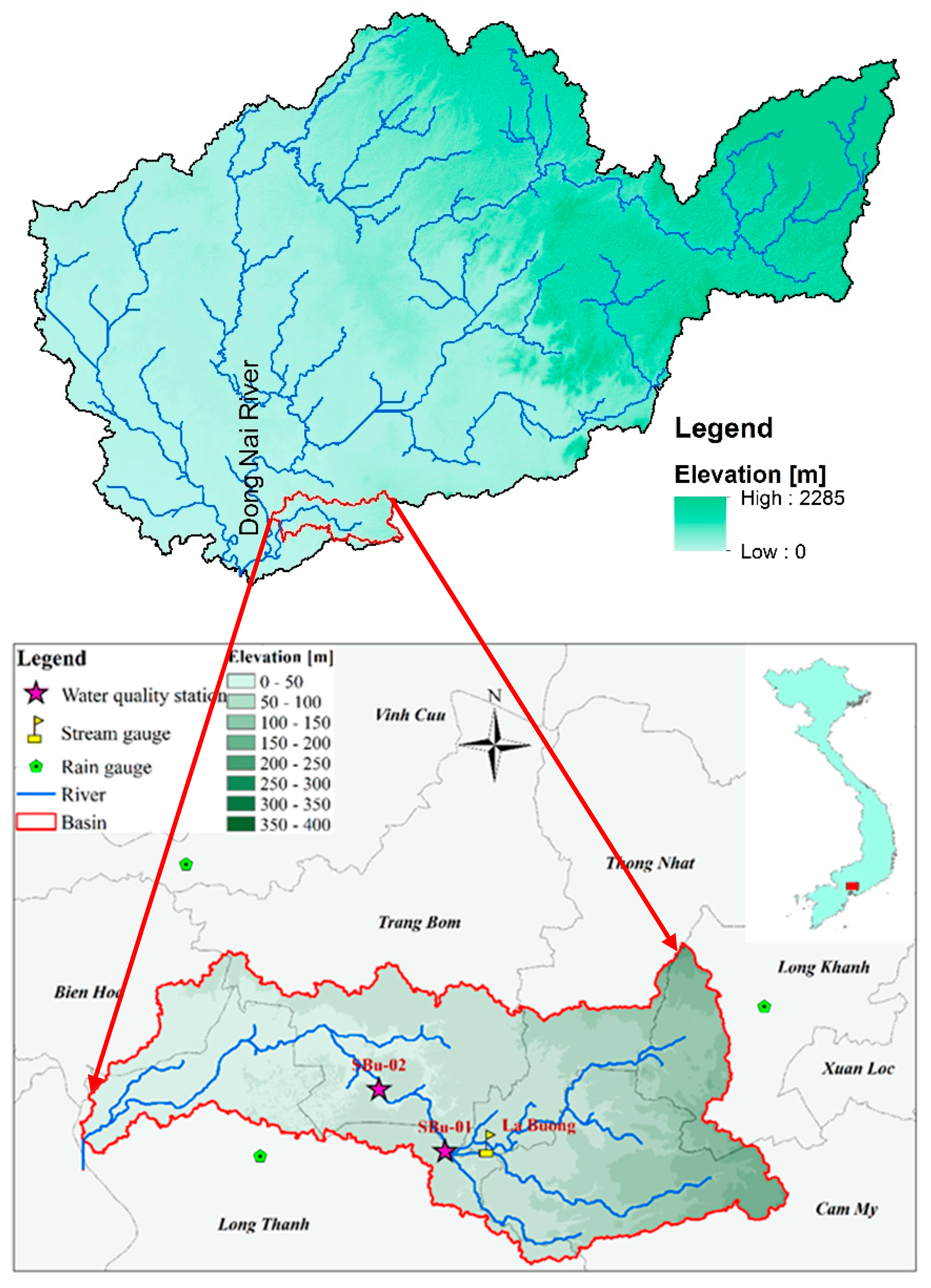
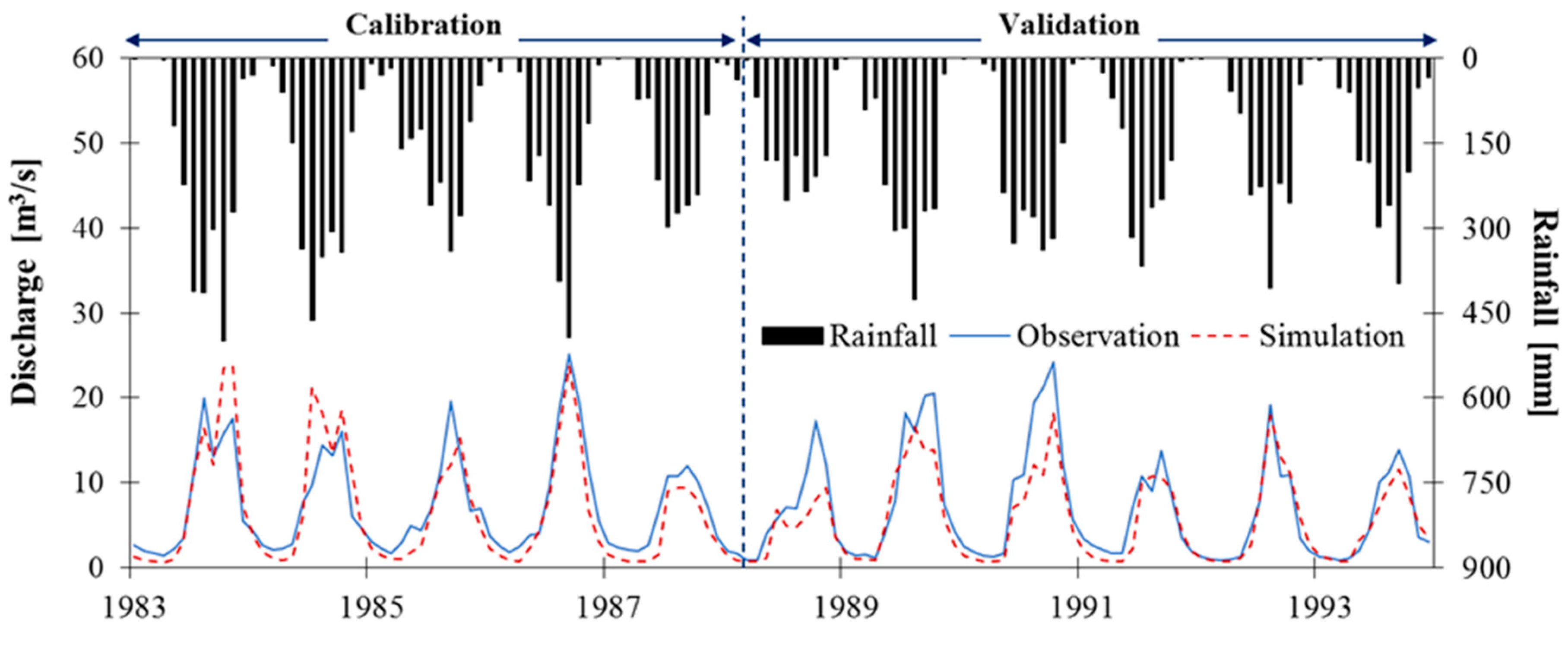
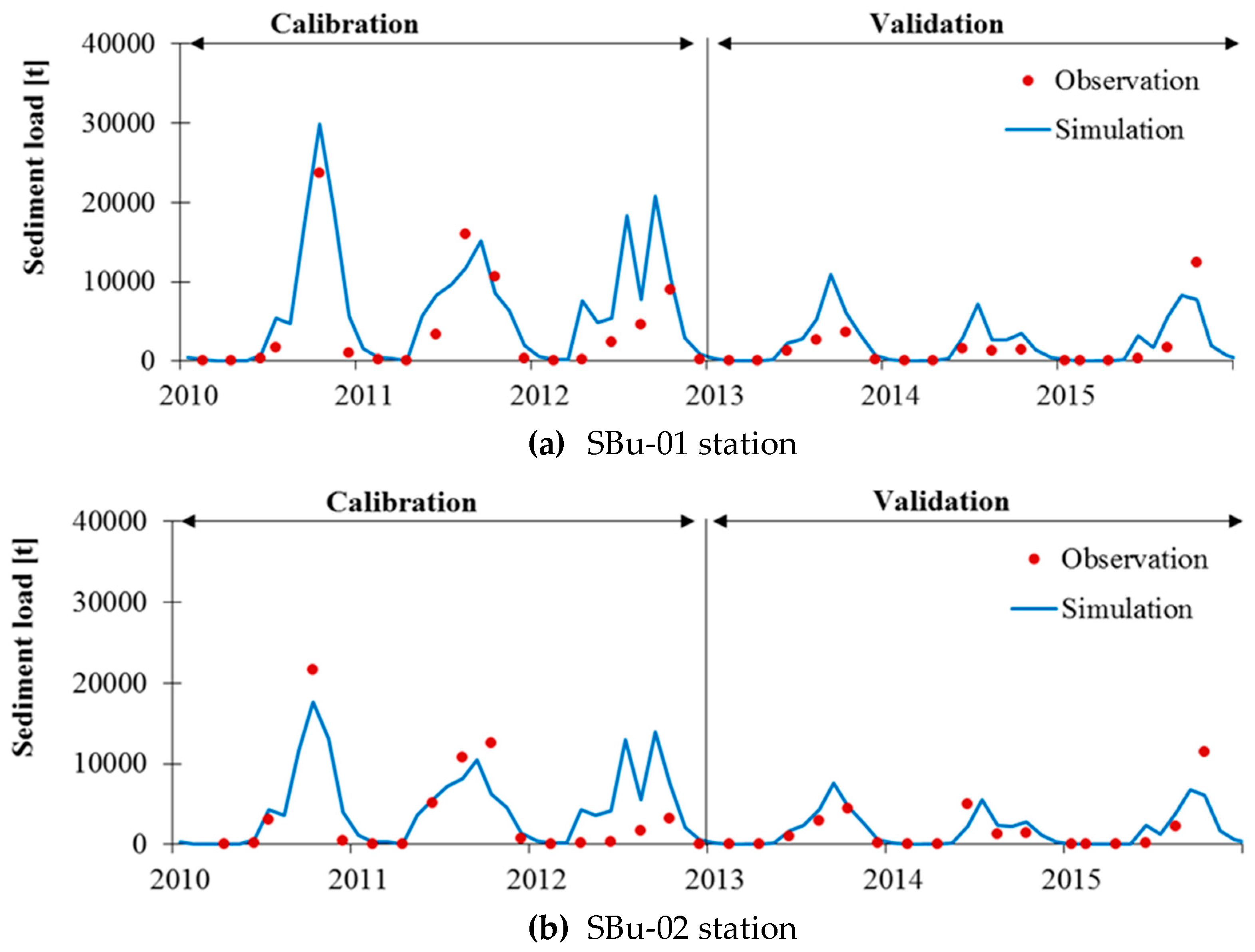
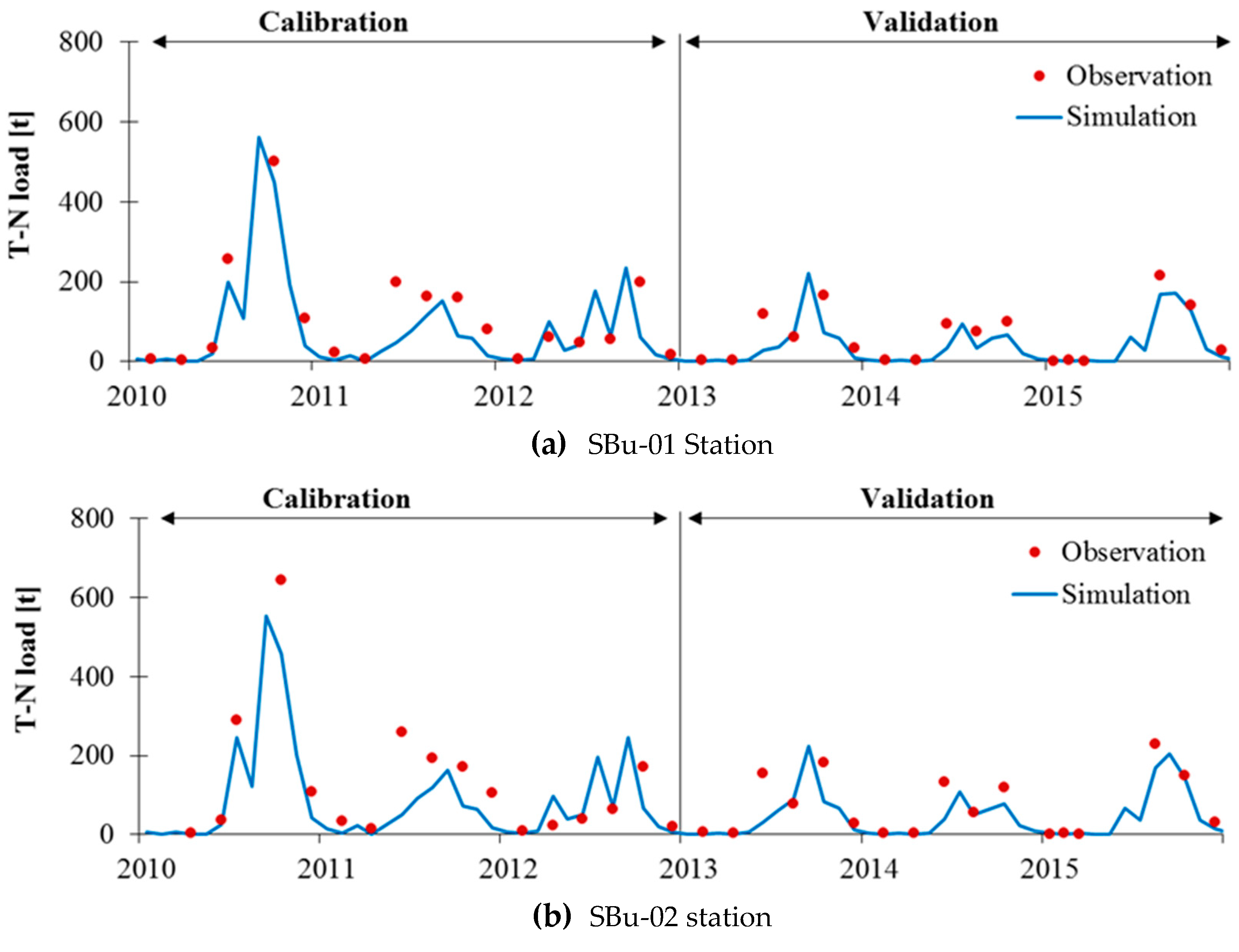
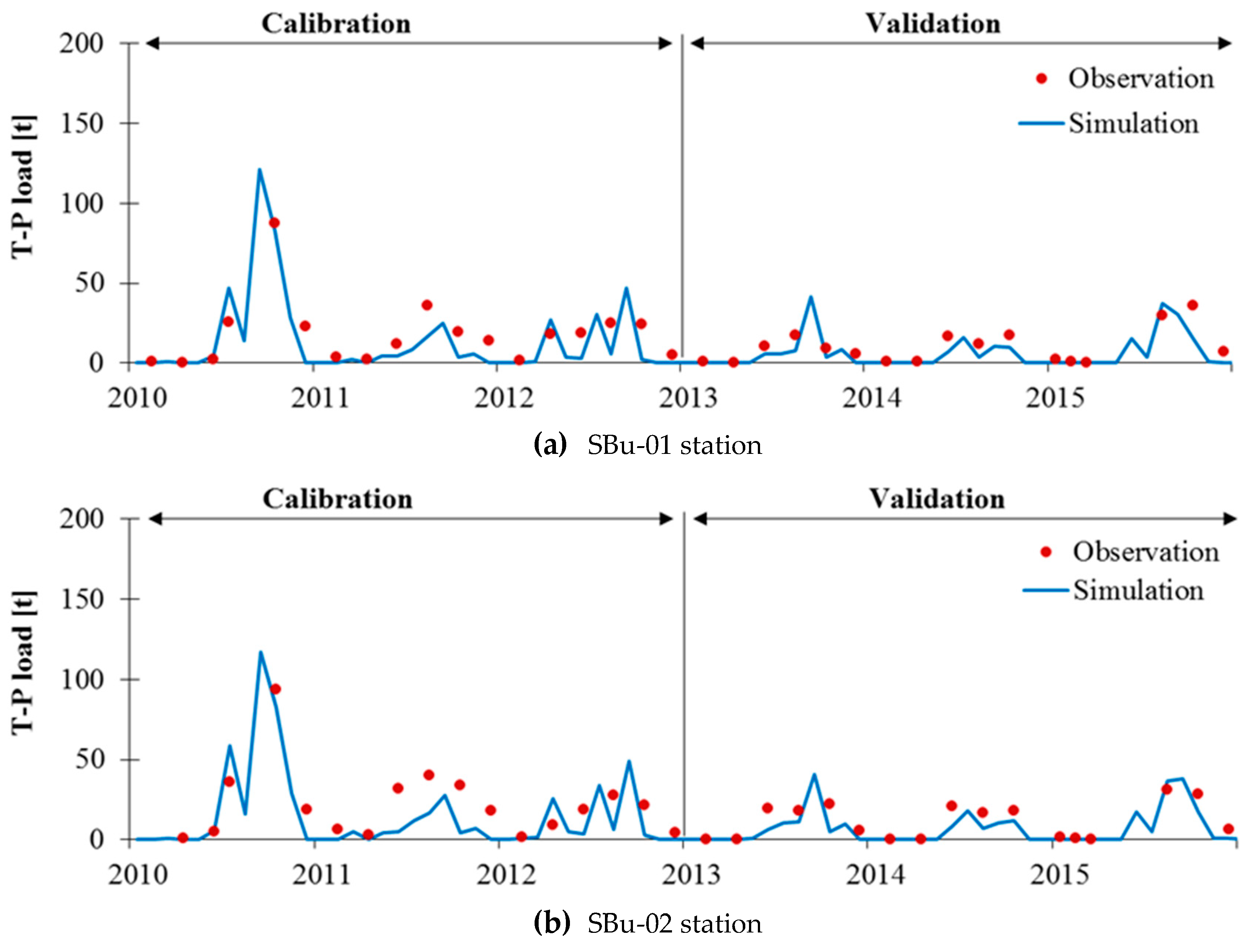
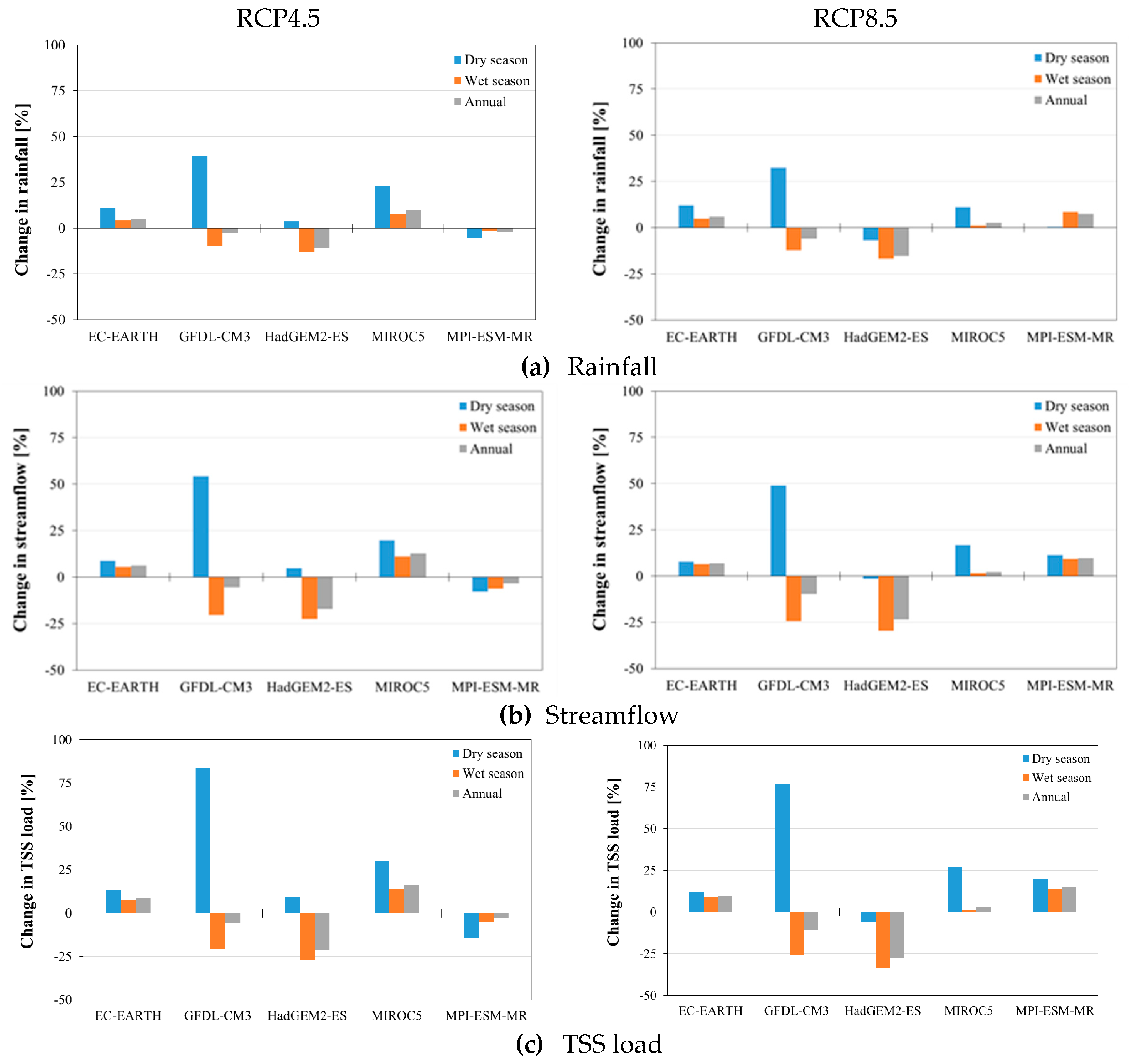
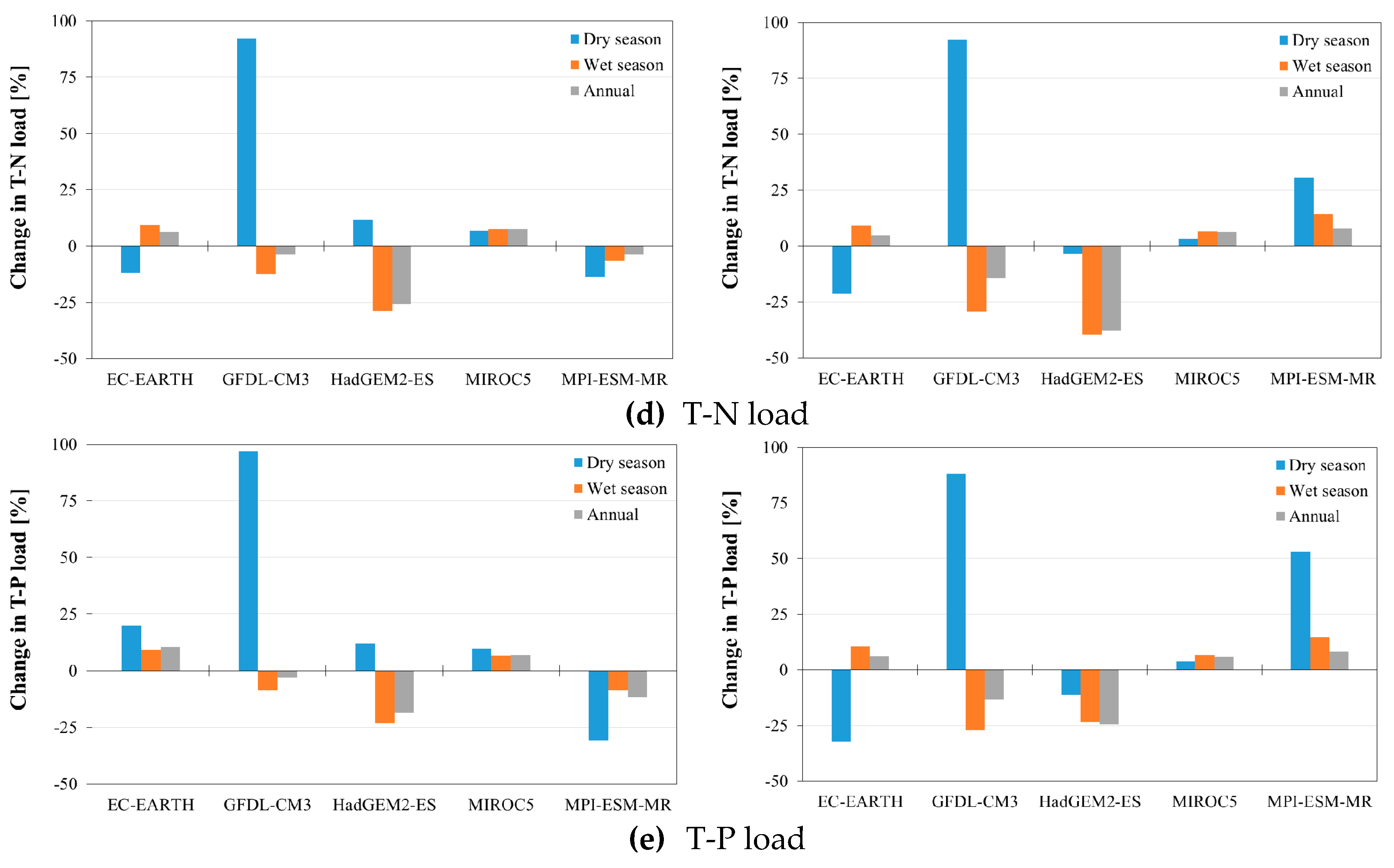
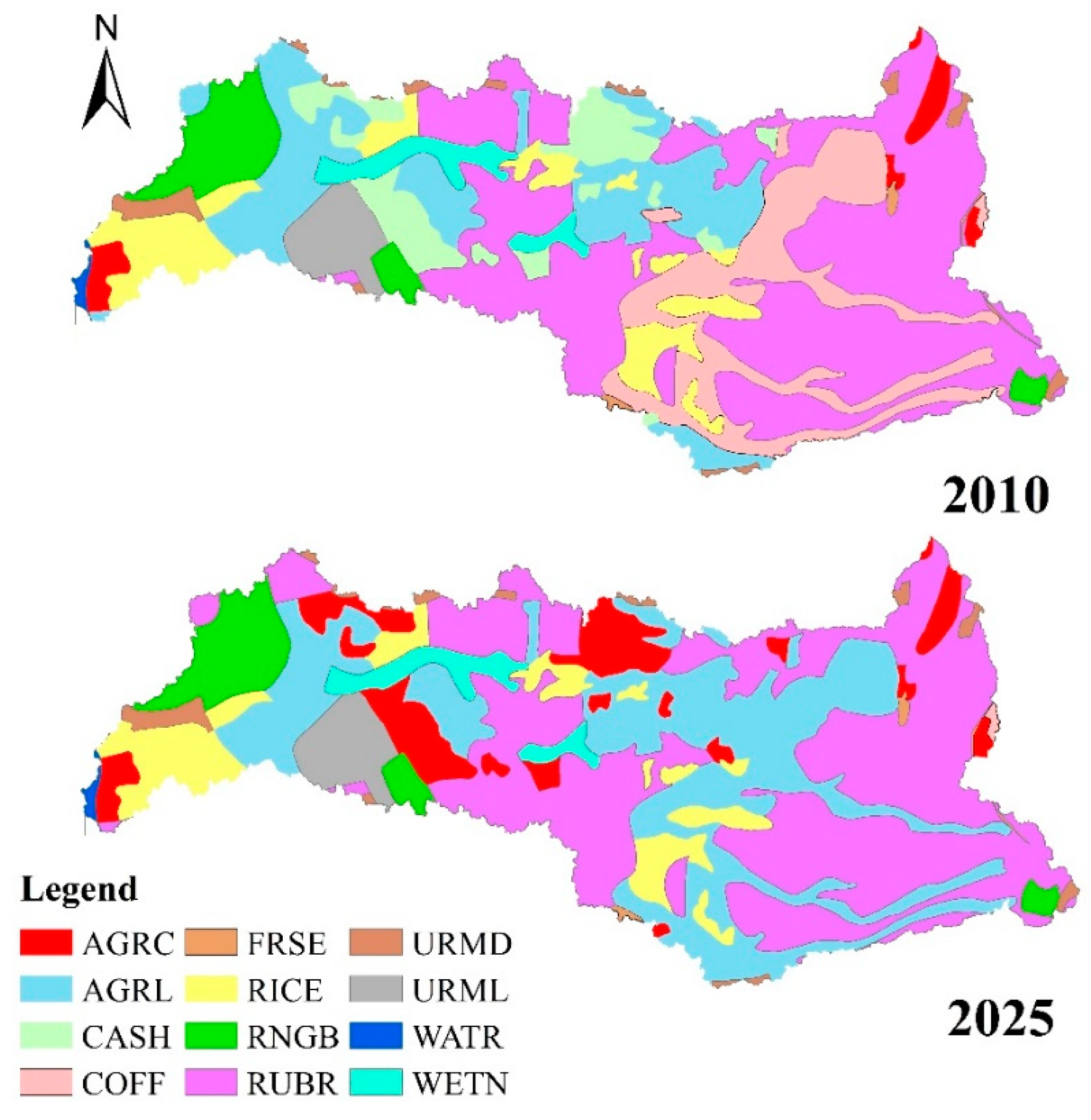
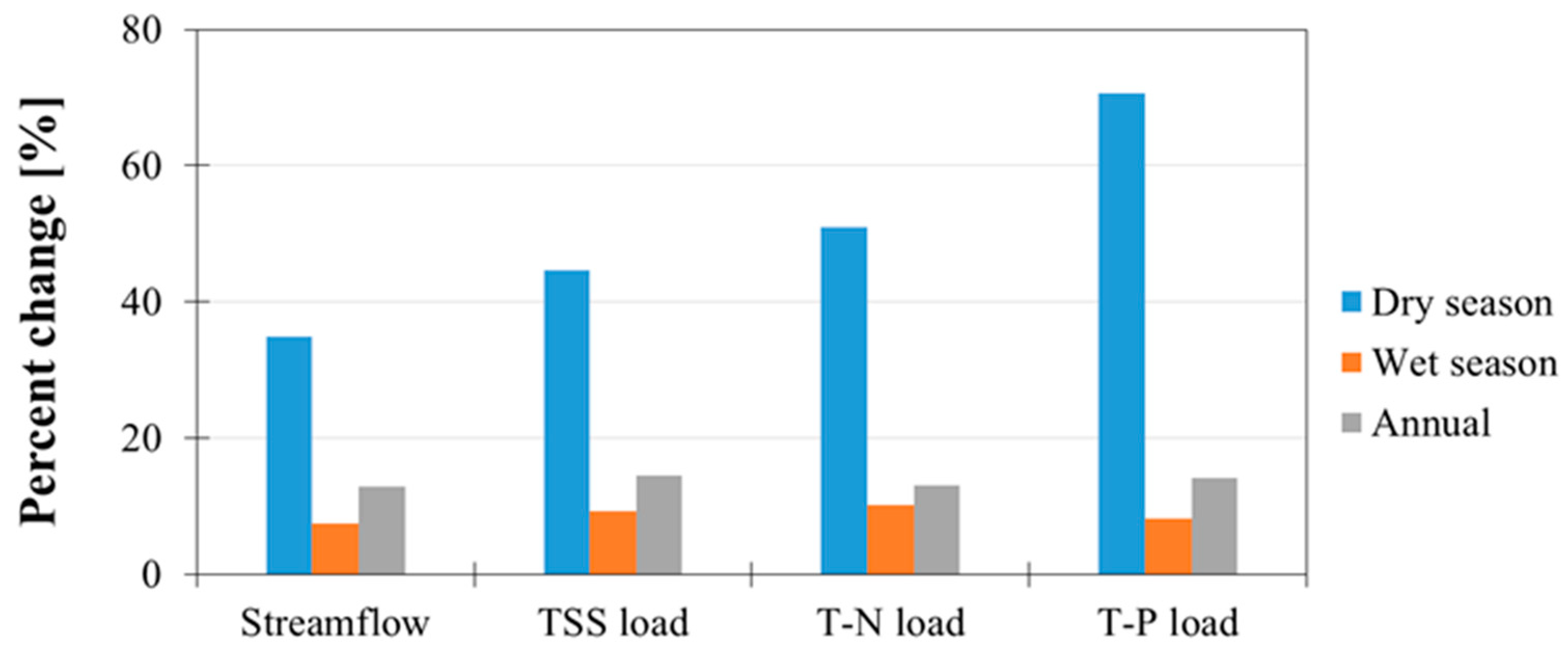
| Component | Flow | Sediment | N | P |
|---|---|---|---|---|
| Very good | R2 > 0.85 NSE > 0.85 | R2 > 0.80 NSE > 0.80 | R2 > 0.70 NSE > 0.70 | R2 > 0.80 NSE > 0.65 |
| Good | ||||
| Satisfactory | ||||
| Not satisfactory |
| No. | Centre | Country | GCM | Resolution |
|---|---|---|---|---|
| 1 | National Oceanic and Atmospheric Administration (NOAA), Geophysical Fluid Dynamics Laboratory | United States | GFDL-CM3 | 2 × 2.5° |
| 2 | European Centre for Medium-Range Weather Forecasts | Europe | EC-EARTH | 1.1215 × 1.125° |
| 3 | UK Met. Office | United Kingdom | HadGEM2-ES | 1.25 × 1.875° |
| 4 | Meteorological Research Institute | Japan | MIROC5 | 1.4008 × 1.40625° |
| 5 | Max-Planck Institute for Meteorology | Germany | MPI-ESM-MR | 1.8653 × 1.875° |
| Parameter | Description of Parameter | Initial Range | Calibrated Value |
|---|---|---|---|
| Parameters used to calibrate streamflow | |||
| v_CH_K2 | Channel effective hydraulic conductivity | −0.01 ÷ 500 | 194 |
| r_CN2 | Initial SCS CN II value | −0.2 ÷ 0.2 | −0.15 |
| v_ESCO | Soil evaporation compensation factor | 0 ÷ 1 | 0.81 |
| v_GWQMN | Threshold water depth in the shallow aquifer for flow | 0 ÷ 5000 | 962 |
| r_REVAPMN | Threshold water depth in the shallow aquifer for “revap” | 0 ÷ 1000 | 757 |
| Parameters used to calibrate sediment loads | |||
| r_SPCON | Linear parameter for calculating the maximum amount of sediment that can be re-entrained during channel sediment routing | −0.20 ÷ 0.20 | −0.13 |
| v_SPEXP | Exponent parameter for calculating sediment re-entrained in channel sediment routing | 1 ÷ 1.5 | 1.4 |
| r_USLE_P | USLE equation support practice | −0.20 ÷ 0.20 | −0.07 |
| Parameters used to calibrate nutrient loads | |||
| v_LAT_ORGN | Organic N in the base flow (mg/l) | 0 ÷ 200 | 56 |
| v_N_UPDIS | Nitrogen uptake distribution parameter | 0 ÷ 100 | 2 |
| v_NPERCO | Nitrogen percolation coefficient | 0 ÷ 1 | 0.48 |
| v_LAT_ORGP | Organic P in the base flow (mg/l) | 0 ÷ 200 | 97 |
| v_P_UPDIS | Phosphorus uptake distribution parameter | 0 ÷ 100 | 14 |
| v_PPERCO | Phosphorus percolation coefficient | 10 ÷ 17.5 | 17 |
| Station | Calibration | Validation | ||||
|---|---|---|---|---|---|---|
| Time Period | R2 | NSE | Time Period | R2 | NSE | |
| Streamflow | ||||||
| La Buong | 1983–1988 | 0.79 | 0.72 | 1989–1993 | 0.87 | 0.82 |
| TSS load | ||||||
| SBu-01 | 2010–2012 | 0.83 | 0.73 | 2013–2015 | 0.62 | 0.54 |
| SBu-02 | 2010–2012 | 0.75 | 0.75 | 2013–2015 | 0.67 | 0.66 |
| T-N load | ||||||
| SBu-01 | 2010–2012 | 0.84 | 0.74 | 2013–2015 | 0.71 | 0.62 |
| SBu-02 | 2010–2012 | 0.84 | 0.71 | 2013–2015 | 0.64 | 0.56 |
| T-P load | ||||||
| SBu-01 | 2010–2012 | 0.72 | 0.56 | 2013–2015 | 0.52 | 0.44 |
| SBu-02 | 2010–2012 | 0.65 | 0.44 | 2013–2015 | 0.51 | 0.40 |
| SWAT Code | Description | 2010 (km2) | 2025 (km2) | Area Change (km2) |
|---|---|---|---|---|
| WATR | Water | 1 | 1 | 0 |
| AGRL | Agricultural land-generic | 66.1 | 119.3 | 53.2 |
| RNGB | Range-brush | 23.1 | 23.1 | 0 |
| COFF | Coffee | 59.5 | 0.6 | −58.9 |
| AGRC | Agricultural close-grown crops | 8.8 | 37.9 | 29.1 |
| URML | Urban medium–low density | 13.2 | 13.2 | 0 |
| RICE | Rice | 35.5 | 35.5 | 0 |
| FRSE | Forest-evergreen | 1.4 | 1.4 | 0 |
| URMD | Urban medium density | 7.4 | 7.4 | 0 |
| WETN | Wetlands-nonforested | 11.4 | 11.4 | 0 |
| CASH | Cashew | 29.1 | 0 | −29.1 |
| RUBR | Rubber | 179 | 184.7 | 5.7 |
| Total | 435.5 | 435.5 | 0 | |
| CC | LUC | CC + LUC | ||||
|---|---|---|---|---|---|---|
| RCP4.5 | RCP8.5 | RCP4.5 | RCP8.5 | |||
| Streamflow (%) | Dry season | 16.1 | 16.3 | 34.9 | 51.7 | 44.1 |
| Wet season | −6.6 | −7.4 | 7.4 | 1.5 | 0.4 | |
| Annual | −1.6 | −2.9 | 12.9 | 12.1 | 11.1 | |
| TSS load (%) | Dry season | 24.3 | 25.8 | 44.6 | 70.3 | 59.3 |
| Wet season | −6.3 | −7.1 | 9.3 | 3.5 | 2.0 | |
| Annual | −0.9 | −2.2 | 14.5 | 14.5 | 13.6 | |
| T-N load (%) | Dry season | 17.0 | 20.3 | 51.0 | 58.1 | 70.8 |
| Wet season | −6.2 | −7.7 | 10.2 | 3.8 | 2.4 | |
| Annual | −3.8 | −6.7 | 13.0 | 9.8 | 8.4 | |
| T-P load (%) | Dry season | 21.5 | 20.3 | 70.6 | 93.7 | 96.6 |
| Wet season | −5.0 | −3.8 | 8.2 | 4.0 | 4.5 | |
| Annual | −3.3 | −3.5 | 14.1 | 11.5 | 11.8 | |
© 2019 by the authors. Licensee MDPI, Basel, Switzerland. This article is an open access article distributed under the terms and conditions of the Creative Commons Attribution (CC BY) license (http://creativecommons.org/licenses/by/4.0/).
Share and Cite
Khoi, D.N.; Nguyen, V.T.; Sam, T.T.; Nhi, P.T.T. Evaluation on Effects of Climate and Land-Use Changes on Streamflow and Water Quality in the La Buong River Basin, Southern Vietnam. Sustainability 2019, 11, 7221. https://doi.org/10.3390/su11247221
Khoi DN, Nguyen VT, Sam TT, Nhi PTT. Evaluation on Effects of Climate and Land-Use Changes on Streamflow and Water Quality in the La Buong River Basin, Southern Vietnam. Sustainability. 2019; 11(24):7221. https://doi.org/10.3390/su11247221
Chicago/Turabian StyleKhoi, Dao Nguyen, Van Thinh Nguyen, Truong Thao Sam, and Pham Thi Thao Nhi. 2019. "Evaluation on Effects of Climate and Land-Use Changes on Streamflow and Water Quality in the La Buong River Basin, Southern Vietnam" Sustainability 11, no. 24: 7221. https://doi.org/10.3390/su11247221
APA StyleKhoi, D. N., Nguyen, V. T., Sam, T. T., & Nhi, P. T. T. (2019). Evaluation on Effects of Climate and Land-Use Changes on Streamflow and Water Quality in the La Buong River Basin, Southern Vietnam. Sustainability, 11(24), 7221. https://doi.org/10.3390/su11247221







